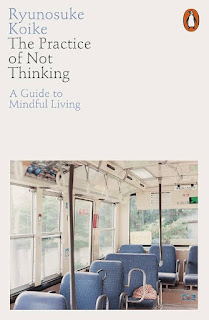Zen Books: The practice of not thinking / The Way of Zen/ Zen Mind: Beginner's Mind/ Living without the head and Eastern illuminaries regarding Dissolution of the Search
The Practice of Not Thinking - Ryunosuke Koike

There is a distinction between thinking and awareness. Thinking is useful when needed, but becomes harmful when constant. On the other hand, awareness connects us with reality, especially through the body and senses. Thoughts are distractions from reality.
Thoughts are often arising from the three poisons or fires, as Buddha says: RAGA clinging/grasping/greed); DYASHA (aversion, anger), and both of them arising from MOHA (ignorance/delusion)
Greed:
Greed is not only a craving for material things but also a mental attachment to outcomes, approval, success, or even happiness. Greed arises when we believe that something outside us will complete or fix us. The mind spins in desire, constantly seeking, which fuels overthinking.
By not thinking, we stop feeding this constant seeking. Returning to the body and the present moment weakens the pull of desire.
Anger:
Anger is tied to the ego’s resistance to reality—wanting things to be other than they are. It often comes when we judge, compare, or expect. Koike suggests that anger is inflamed by thought loops: “This shouldn’t have happened,” “Why me?” etc.
Stepping away from those thought patterns through mindful presence dissolves the mental fuel that sustains anger.
Ignorance:
Ignorance is not a lack of knowledge, but a disconnection from direct experience. It’s the habit of living in the mind’s narratives instead of the present. This is the deepest poison—being unaware of our awareness.
Koike emphasizes cultivating awareness of bodily sensations and breath. This grounds us in reality and clears the fog of ignorance.
Hearing:
The modern world overwhelms us with noise—traffic, chatter, endless distractions. This overstimulation makes it hard to focus, even when we should. Poor listening strains relationships and disconnects us from the world.
For example, listening to music before a meeting might make a colleague’s voice seem dull by comparison. Your mind drifts, filtering out their words, leaving you disengaged.
But if, instead, you take a moment to notice quiet background sounds—AC hum, footsteps, rustling papers—you train your mind to embrace the ordinary. When the meeting starts, you listen effortlessly, fully present.
This practice stems from dependent arising, a Buddhist concept highlighting interconnectedness. Listening attentively in one moment improves focus in the next. Paying attention to a partner at home helps you listen better at work. Noticing the sounds of your commute sharpens your awareness in conversations. Each act of mindful listening strengthens the next, creating a ripple effect of presence.
Seeing:
Your eyes, like your ears, are flooded with constant input—endless feeds, violent games, shocking news. A person from the 1800s would be stunned by how much we consume without thought. But mindlessness is the problem—we rarely consider what we expose ourselves to.
Overstimulation comes from both quantity (doom-scrolling for hours) and content (harrowing images, aggressive media). Buddhists warn that intense visuals dull our sensitivity to subtler, quieter scenes. The solution? Avoid overstimulating imagery, especially what fuels anger or chaos. A cluttered room feels more agitating than a clean one; the same goes for violent films or sensational news.
Instead, seek calm, neutral visuals. Try mindful seeing: next time you walk, notice details—a street sign growing closer, then fading away. Observe sunlight on walls, rustling leaves. By focusing on the ordinary, the "boring" becomes vivid.
No drastic changes needed—just awareness. Train your eyes to see simply, and your mind grows sharper, more present.
Work bombards you with noise—calls, chats, endless tasks. Your mind scatters, your body tenses. The antidote? Focus on touch.
Sitting restless at your desk? Notice where your body meets the chair. Feel the seat supporting you, the backrest against your spine. Awareness alone eases tension and improves posture.
Struggling to focus while typing? Shift attention to your fingertips. Feel the keyboard’s resistance, the slight muscle movements. This tactile anchor sharpens concentration.
When overwhelmed, step away. Tidy up, walk, cook—just notice touch: feet on the floor, a spoon in your hand, the vacuum’s grip. These small sensations reset a noisy mind.
Touch grounds you. By tuning into physical details, you silence mental chaos and reclaim focus—turning everyday moments into mindful pauses.
The Way of Zen: Allan Watts

Zen’s Roots in Taoism and Buddhism:
Zen Buddhism blends Chinese Taoist philosophy with Indian Mahayana Buddhism. Taoism emphasizes intuitive knowledge—like trusting your breath without overanalyzing it—while Buddhism teaches liberation from illusions (Maya) and the realization that the self is a construct. Zen emerged when monks like Bodhidharma and Hui Neng fused these ideas, focusing on direct experience over doctrine.
The Illusion of Seeking Happiness
Zen rejects the pursuit of happiness as a paradox: comfort only exists because of discomfort. Instead of chasing an ideal, Zen teaches acceptance of life’s natural flow. You might compare the pursuit of happiness to turning from left to right on a hard bed. You're uncomfortable on the right side, so you turn to the left. That feels good at first, but then the left starts to feel exactly like the right. In fact, the only reason you can understand the feeling of comfort is because you first understood discomfort. So discomfort is not only inevitable, but simply another aspect of comfort.
The Power of the Present Moment
Zen dismisses rigid divisions of time (past/future) and self ("I am my roles"). Reality exists only now. Practices like zazen (sitting meditation) aren’t about achieving purity but observing the mind’s "muddy river" until it clears naturally. Koans—paradoxical riddles—train the mind to respond creatively, without overthinking.
4. Art as Enlightenment
Zen art—sumi-e paintings, haiku, and minimalist gardens—uses emptiness to evoke freedom. A single brushstroke or a 3-line poem invites the viewer to complete the meaning, mirroring Zen’s emphasis on direct experience over explanation.
5. Living Zen
Zen isn’t passive resignation but radical presence. Breathe without forcing it; let actions arise naturally. By dropping illusions—of control, permanence, or a fixed self—we align with the "aimless" joy of existence. As Alan Watts clarifies, Zen isn’t tranquility alone but waking up to reality as it is: fleeting, spontaneous, and complete in each moment.
Zen Mind, Beginner’s Mind: Shunryu Suzuki

1. Posture as Practice
Zen meditation begins with the physical posture—cross-legged (ideally lotus position), spine straight, and weight centered below the navel. This stance isn’t just practical; it symbolizes non-duality, dissolving boundaries between body/mind, life/death, and self/world. By sitting this way, you embody Zen’s core truth: all distinctions are illusions.
2. Breathing as Awareness
Zen breathing isn’t about control but observation. By focusing on the inhale and exhale, you recognize the unity of inner and outer worlds. Breath dissolves the ego’s illusion of separation and even time itself—there’s only the present moment, flowing like the air passing through you.
3. The Futility of Control
Western culture obsesses over control, but Zen teaches letting go. Like herding sheep in an open field (not a cramped pen), people—and thoughts—flourish when allowed freedom. In meditation, don’t suppress thoughts; observe them and return to the breath. Life’s chaos can’t be managed, only witnessed.
4. Adversity as Fuel
Struggles in meditation—restlessness, fatigue, discouragement—aren’t setbacks but fertilizer for growth. Like weeds enriching soil, challenges strengthen practice. Effort matters, but it’s the effort to persist, not to force results. Waves of difficulty will diminish with time.
5. Success Without Excellence
Zen flips Western ideals: the "worst" students (those who struggle) often progress furthest because they learn resilience. Natural talent can plateau, while perseverance cultivates depth. Zen values consistent practice over effortless achievement.
6. The Myth of Excitement
Modern life addicts us to stimulation, but Zen finds richness in ordinary moments—eating, cleaning, working. The goal isn’t excitement or achievement but pure engagement. Drop pride in practice; just sit, just breathe, just be.
Zen isn’t about attaining happiness or enlightenment. It’s awakening to the present, through posture, breath, and daily acts—free from judgments, goals, or distractions. As Suzuki reminds us: "In the beginner’s mind, there are many possibilities; in the expert’s, few."
Living Without a Head - Douglas Harding
Drawing on Zen, mysticism, and direct observation, Harding proposes that our true nature is not what we appear to others — a person with a head — but what we experience firsthand: an open, headless space where the world is seen. From the first-person point of view, he argues, we never actually see our own head — only the world appearing in awareness. This “headlessness” reveals our essential identity as pure consciousness, free from ego and form.
Harding guides the reader through simple, direct experiments to uncover this insight. For example, pointing at one’s own “head” reveals not a physical object but a clear, formless field of vision. These exercises are meant to dissolve the illusion of a separate, bounded self and instead awaken a direct experience of unity with the world. The book’s tone is practical and inviting, offering a path to self-realization that is grounded in immediate perception rather than belief or philosophical reasoning.
The central distinction Harding makes is between the “constructed self” — the socially defined personality we see in the mirror and imagine ourselves to be — and the “real self,” which is the ever-present, spacious awareness in which experience unfolds. By living from this headless perspective, one can experience freedom from self-consciousness, inner conflict, and the burden of maintaining a fixed identity.
Nisargadatta Maharaj: Nisargadatta’s Advaita Vedanta approach is direct and uncompromising: You are already That (pure awareness), and the search for it only perpetuates the illusion of separation. His famous dictum: “The search for reality is the most dangerous of all undertakings, for it destroys the world in which you live.”
Jiddu Krishnamurti: Truth is a pathless land. He rejected all organized paths, methods, or systems—arguing that the search itself is the continuation of the self, and thus cannot lead to truth. For him, truth can only emerge in choiceless awareness, not in the accumulation of knowledge or adherence to tradition. The moment you follow someone, you cease to follow truth.
Zen Buddhism: No mind, no search, direct experience. Zen emphasizes satori (sudden awakening), often triggered by the collapse of rational inquiry. Koans (paradoxical questions) are designed to short-circuit intellectual reasoning, leading to non-conceptual realization.
Heidegger: Being is not found through calculative thinking. In Being and Time, he contrasts calculative thinking with meditative thinking, suggesting that being is disclosed not through manipulation or pursuit, but through letting-be, through openness to Being. Although not mystical, he gestures toward a mode of openness beyond intellectual grasping.



.jpeg)





.jpg)
Comments
Post a Comment